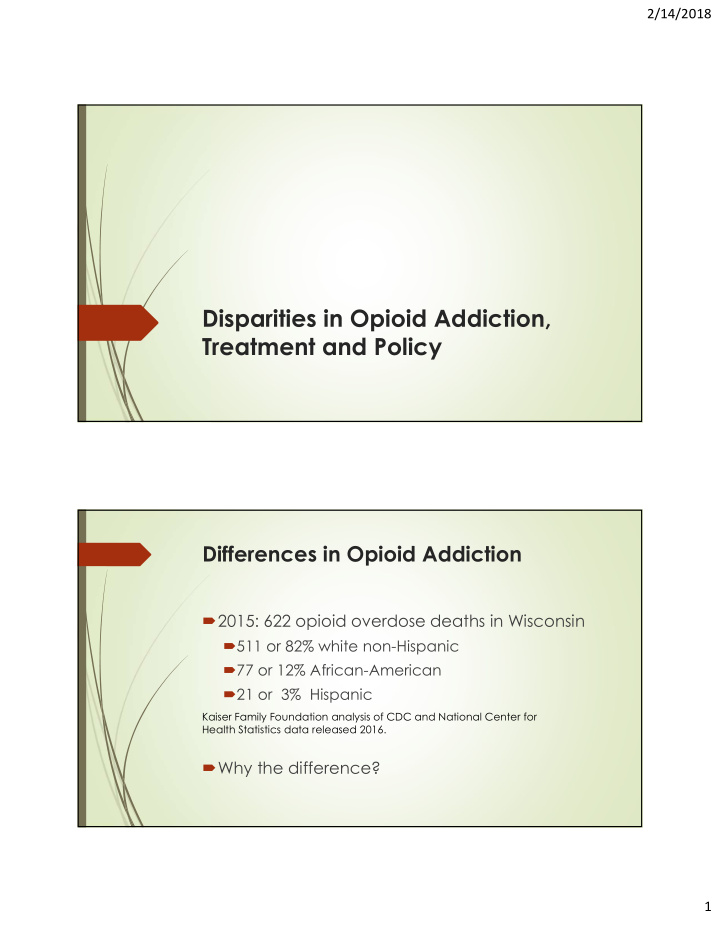



2/14/2018 Disparities in Opioid Addiction, Treatment and Policy Differences in Opioid Addiction 2015: 622 opioid overdose deaths in Wisconsin 511 or 82% white non-Hispanic 77 or 12% African-American 21 or 3% Hispanic Kaiser Family Foundation analysis of CDC and National Center for Health Statistics data released 2016. Why the difference? 1
2/14/2018 History of Opioid Prescription 1990s Major campaigns by JCAHO and VHA* Established new standards for monitoring and treatment of pain in 2000 Pain management became important quality improvement initiative DEA shows marked quantitative increases in opioid prescriptions every year since 1990 * Joint Commission on Accreditation of Healthcare Organizations and Veterans Health Administration Theory for Racial Disparities Doctors prescribed narcotics more cautiously to their non-white patients Unconscious bias related to: Concern about patients becoming addicted Concern patients might sell their pills Less concern about pain levels in non-white population Racial stereotyping is having a protective effect on non-white populations. Andrew Kolodny, MD, co-director of Opioid Policy Research Collaborative, Brandeis University 2
2/14/2018 The Evidence Comprehensive pain study from University of Michigan Medical School: Health care disparities, racial and ethnic disparities in pain perception, assessment and treatment were found in all settings Emergency Department Hospital (post-operative) Outpatient and across all types of pain Acute Cancer Chronic nonmalignant Disparate Treatment of Pain In Emergency Rooms: 1993 Todd et al study found 55% of Hispanics with isolated humerus, radius, ulna, femoral shaft, tibia and fibula fractures went without pain medication compared to 26% of white non-Hispanic patients 2000 Todd et al study found 57% of African-American patients with acute, isolated long-bone fractures received pain medication compared to 74% of white non-Hispanic patients. 3
2/14/2018 Disparate Treatment of Pain Post-operative pain management 1996 Ng et al study found patients received on average different daily does of morphine White non-Hispanic received 22mg/day African-Americans received 16mg/day Hispanics received 13mg/day Cancer pain 1997 Cleeland et al study found that centers that predominantly treat racial and ethnic minorities were less likely to follow WHO recommend levels of pain management 74% of Hispanic patients did not receive adequate pain management 59% of African-American patients did not receive adequate pain management Chronic Pain Management 2005 Chen et al study found: African-Americans had significantly higher pain scores than white patients 6.7 versus 5.6 White patients were prescribed opioid analgesics more frequently than African-Americans 45.7% versus 32.2% No difference by race in the use of other treatment modalities Racial disparity not due to problems of access 4
2/14/2018 Policy Disparities Opioids not the first drug epidemic 1980s and 1990s crack cocaine epidemic predominantly affected African-American communities Policy stance: No government declaration of a public health crisis War on drugs; we could potentially arrest our way out of the problem Today’s policy stance: Declaration by Trump administration of a public health crisis We can’t arrest our way out of the problem Need for effective treatment and prevention 5
Recommend
More recommend